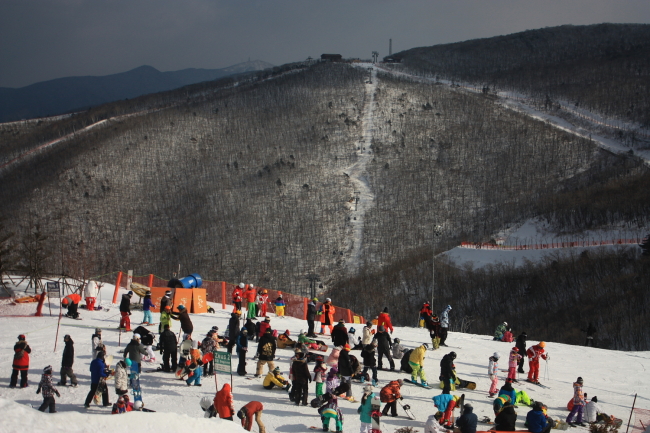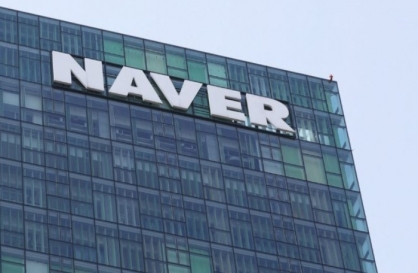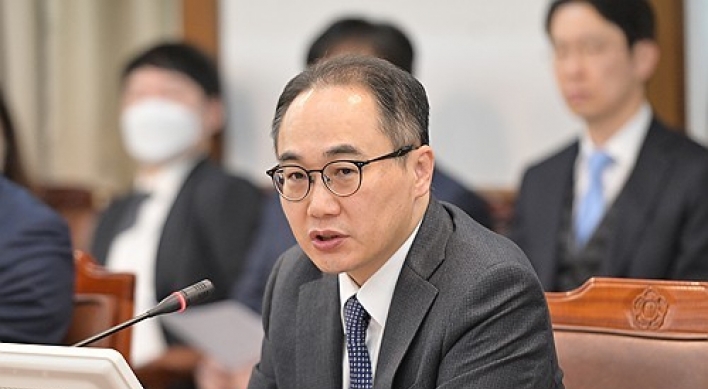
GOHAN-EUP, Gangwon Province ― Driving into Gohan-eup, it’s easy to mistake the isolated hamlet for just another ski town. Gohan serves as the gateway to the High1 Resort, and shops stocked with skis and snowboards line the road through the narrow mountain valley. In between the rental shops, though, attentive visitors will notice just as many pawn shops and loan agencies.
The pawn shops (labeled “jeondangsa” in Gohan) don’t target ski bums, but gamblers. They signal the proximity of Kangwon Land, the only casino in Korea where locals are allowed in. Kangwon Land Inc. has followed up the casino with the ski hill, a golf course and various other ventures.
However, one would have to dig deeper into the town’s past to discover that it has only recently become a retreat for thrill seekers. Until 1989, when operations winded down, Gohan was a coal mining town. The closest city is Taebaek, the most famous Korean coal town of all, and there used to be nearly 50 active mines in the area.
On the white
According to a facetious adage, if the mountainous terrain of Korea was completely ironed out, the country would be as large as China. Barring the existence of a cosmic steamroller, though, Korea is likely to remain an ideal country for yearlong hiking and for skiing and snowboarding in winter. Though the snow sometimes falls in moderation and melts early in spring, the country’s winter sports industry has crystallized over the past decade or so. A high point for South Korea came in 2011 when it won its bid for the 2018 Winter Olympics.
While Japan has more than 600 resorts and North Korea has recently opened its first ― Masik Pass, a pet project of young leader Kim Jong-un ― the South currently has 17. Choosing a place to ski or snowboard is a question of proximity for most, and the number and quality of the runs for many. For Lee Dong-il, an employee at Board Korea in Nonhyeon-dong, southern Seoul, the nation’s retail hub for winter sports, the all-around best ski hill is High1.
“First of all, I like its clean facilities. Second it has a lot of different slopes,” he said as he used a power screwdriver to fix a set of bindings onto a newly purchased snowboard. He also spoke highly of the selection of jumps at the terrain park and the long half-pipe.
Ultimately, though, Lee says he just likes the atmosphere of the place. While most resorts feature runs on two or three sides of a single mountain, High1’s feed down the adjoining slopes of a valley; they are steep and mostly of intermediate or advanced difficulty. Most of the hill’s regulars are snowboarders who travel up from the Gyeongsang provinces.
High1 opened in 2007 and is one of the highest local resorts, topping out at 1,340 meters (Yongpyong Resort’s gondolas unload about 100 meters higher). The winding 4 km run from Zeus 2 to Zeus 3 also competes with Yongpyong’s Rainbow Paradise (5.6 km) in sheer distance and Deogyusan Resort’s Silk Road, the country’s longest at 6.1 km.
But beginners and experts alike will probably want to avoid High1’s Zeus route. The narrow course attracts a deadly mix of unsure beginners and renegade advanced boarders who use it as a moving obstacle course. Beginners can find a less nerve-racking practice slope in Athena 1, below the Mountain Hub. Meanwhile, experts can hit the slopes labeled orange and purple, which are depopulated even on weekends. The artificial snow on these steep courses is well groomed, with not too many icy patches.
The resort has also taken practical Korean ski innovations to a new level. Like the country’s subway stations, the lifts are equipped with automated turnstiles and electronic sensors for lift passes. The gondola system, too, is ingenious. Each of the condos and hotels ― even the distant golf course hotel ― has a gondola boarding station, with service straight to the top. The wait time for the Mountain Gondola was tolerable even on a Saturday afternoon, while at Konjiam Resort, only 30 minutes from Gangnam, southern Seoul, wait times on the weekend stretched to half an hour.
Like other local resorts, High1 offers a grab bag of lift pass options ― 10 of them, in fact, from “Daytime” (8:30 a.m.-5:00 p.m.) to “Night/Morning” (6:30 p.m.-1:00 a.m.). Night skiing is an excellent option for the tight-scheduled, the budget-savvy or the crowd-averse who don’t mind the extra chill in the air.
The resort even manages to attract people who neither ski nor snowboard. After buying a “Tourist Gondola” pass, these interlopers can enjoy a lunch with a commanding view at the Mountain Top Restaurant.
Information about High1 is available in Korean, English, Japanese and Chinese at www.high1.com.
In the red
Further down the hill from the High1 lodge is the impossible-to-miss Kangwon Land complex. A slice of Macau in the heart of the Taebaek Mountain Range, it’s illuminated at night with a full spectrum of lighting technology. It is also fronted by a twinkling fairy tale castle that looks deceptively solid but is actually a “Potemkin castle.”
Of the 17 casinos in South Korea, only Kangwon Land can admit local gamblers. This exclusive privilege was secured in 1995 with the Special Act on the Assistance to the Development of Abandoned Mine Areas, and the casino started taking bets in 2003.
Besides housing the only five-star hotel in Gangwon Province, the complex also includes a wine shop, bakery cafe, swimming pool, sauna, gym and cinema, where the show “Le Mystere” is currently being performed.
Unlike most casinos, this one has an entrance charge ― recently raised to 7,500 won ($7). To buy a ticket (the ticket counter is in the building across from the casino) Koreans must present their identity card while foreigners are advised to bring their passport, at least on their first visit, when computer registration takes place.
The adjacent building also houses the KL Addiction Care Center. Interestingly, problem gamblers can be banned upon their own request, through the intervention of family members or by the establishment itself. For those who pass the inspection process and secure a ticket, the only remaining obstacles are a metal detector and baggage scanner. Photography is not allowed and cameras are sealed in plastic pouches at this point.
On this Saturday evening, more than 4,200 entrance tickets had been sold by 6:30 p.m. and the spacious hall was packed. Players had to wait at the edges of roulette tables for a chance to snag a seat and buy a stack of chips from the dealer. The 1,000 or so slot machines ― mostly computerized, some low-tech ― were all taken by patrons wagering at least 100 won a try. Though some of the visitors were young Koreans fresh off the slopes, most were over the hill.
Lee Dong-il, the snowboard shop employee, had said that the casino “could be another merit” of the resort, adding, “I understand why High1 is not open after midnight, so that people go there and spend money.”
Incidentally, Gangwon Land doesn’t rely on free food or alcohol to lure guests, a fallback strategy of many casinos. Complimentary juice and soft drinks are on tap next to a row of baccarat tables on the fifth floor, but at the restaurant a plate of curry and rice goes for 26,000 won. Thrill seekers on a budget will surely be discouraged by this, and may want to stay at High1, closer to the numerous Steff Hotdog stands and the slippery, habit-forming slopes.
For more information on the casino, visit kangwonland.high1.com.
Getting there
Gohan Station can be reached in about 3.5 hours by train from Cheongnyangni Station, Seoul. A shuttle bus to the Casino and Mountain Ski House leaves from Gohan Station every 15 minutes during peak hours. Buses depart from Dong Seoul Bus Terminal, eastern Seoul, to Shin Gohan, a short taxi ride from Gohan-eup.
By Matthew C. Crawford (mattcrawford@heraldcorp.com)
The pawn shops (labeled “jeondangsa” in Gohan) don’t target ski bums, but gamblers. They signal the proximity of Kangwon Land, the only casino in Korea where locals are allowed in. Kangwon Land Inc. has followed up the casino with the ski hill, a golf course and various other ventures.
However, one would have to dig deeper into the town’s past to discover that it has only recently become a retreat for thrill seekers. Until 1989, when operations winded down, Gohan was a coal mining town. The closest city is Taebaek, the most famous Korean coal town of all, and there used to be nearly 50 active mines in the area.
On the white
According to a facetious adage, if the mountainous terrain of Korea was completely ironed out, the country would be as large as China. Barring the existence of a cosmic steamroller, though, Korea is likely to remain an ideal country for yearlong hiking and for skiing and snowboarding in winter. Though the snow sometimes falls in moderation and melts early in spring, the country’s winter sports industry has crystallized over the past decade or so. A high point for South Korea came in 2011 when it won its bid for the 2018 Winter Olympics.
While Japan has more than 600 resorts and North Korea has recently opened its first ― Masik Pass, a pet project of young leader Kim Jong-un ― the South currently has 17. Choosing a place to ski or snowboard is a question of proximity for most, and the number and quality of the runs for many. For Lee Dong-il, an employee at Board Korea in Nonhyeon-dong, southern Seoul, the nation’s retail hub for winter sports, the all-around best ski hill is High1.
“First of all, I like its clean facilities. Second it has a lot of different slopes,” he said as he used a power screwdriver to fix a set of bindings onto a newly purchased snowboard. He also spoke highly of the selection of jumps at the terrain park and the long half-pipe.
Ultimately, though, Lee says he just likes the atmosphere of the place. While most resorts feature runs on two or three sides of a single mountain, High1’s feed down the adjoining slopes of a valley; they are steep and mostly of intermediate or advanced difficulty. Most of the hill’s regulars are snowboarders who travel up from the Gyeongsang provinces.
High1 opened in 2007 and is one of the highest local resorts, topping out at 1,340 meters (Yongpyong Resort’s gondolas unload about 100 meters higher). The winding 4 km run from Zeus 2 to Zeus 3 also competes with Yongpyong’s Rainbow Paradise (5.6 km) in sheer distance and Deogyusan Resort’s Silk Road, the country’s longest at 6.1 km.
But beginners and experts alike will probably want to avoid High1’s Zeus route. The narrow course attracts a deadly mix of unsure beginners and renegade advanced boarders who use it as a moving obstacle course. Beginners can find a less nerve-racking practice slope in Athena 1, below the Mountain Hub. Meanwhile, experts can hit the slopes labeled orange and purple, which are depopulated even on weekends. The artificial snow on these steep courses is well groomed, with not too many icy patches.
The resort has also taken practical Korean ski innovations to a new level. Like the country’s subway stations, the lifts are equipped with automated turnstiles and electronic sensors for lift passes. The gondola system, too, is ingenious. Each of the condos and hotels ― even the distant golf course hotel ― has a gondola boarding station, with service straight to the top. The wait time for the Mountain Gondola was tolerable even on a Saturday afternoon, while at Konjiam Resort, only 30 minutes from Gangnam, southern Seoul, wait times on the weekend stretched to half an hour.
Like other local resorts, High1 offers a grab bag of lift pass options ― 10 of them, in fact, from “Daytime” (8:30 a.m.-5:00 p.m.) to “Night/Morning” (6:30 p.m.-1:00 a.m.). Night skiing is an excellent option for the tight-scheduled, the budget-savvy or the crowd-averse who don’t mind the extra chill in the air.
The resort even manages to attract people who neither ski nor snowboard. After buying a “Tourist Gondola” pass, these interlopers can enjoy a lunch with a commanding view at the Mountain Top Restaurant.
Information about High1 is available in Korean, English, Japanese and Chinese at www.high1.com.
In the red
Further down the hill from the High1 lodge is the impossible-to-miss Kangwon Land complex. A slice of Macau in the heart of the Taebaek Mountain Range, it’s illuminated at night with a full spectrum of lighting technology. It is also fronted by a twinkling fairy tale castle that looks deceptively solid but is actually a “Potemkin castle.”
Of the 17 casinos in South Korea, only Kangwon Land can admit local gamblers. This exclusive privilege was secured in 1995 with the Special Act on the Assistance to the Development of Abandoned Mine Areas, and the casino started taking bets in 2003.
Besides housing the only five-star hotel in Gangwon Province, the complex also includes a wine shop, bakery cafe, swimming pool, sauna, gym and cinema, where the show “Le Mystere” is currently being performed.
Unlike most casinos, this one has an entrance charge ― recently raised to 7,500 won ($7). To buy a ticket (the ticket counter is in the building across from the casino) Koreans must present their identity card while foreigners are advised to bring their passport, at least on their first visit, when computer registration takes place.
The adjacent building also houses the KL Addiction Care Center. Interestingly, problem gamblers can be banned upon their own request, through the intervention of family members or by the establishment itself. For those who pass the inspection process and secure a ticket, the only remaining obstacles are a metal detector and baggage scanner. Photography is not allowed and cameras are sealed in plastic pouches at this point.
On this Saturday evening, more than 4,200 entrance tickets had been sold by 6:30 p.m. and the spacious hall was packed. Players had to wait at the edges of roulette tables for a chance to snag a seat and buy a stack of chips from the dealer. The 1,000 or so slot machines ― mostly computerized, some low-tech ― were all taken by patrons wagering at least 100 won a try. Though some of the visitors were young Koreans fresh off the slopes, most were over the hill.
Lee Dong-il, the snowboard shop employee, had said that the casino “could be another merit” of the resort, adding, “I understand why High1 is not open after midnight, so that people go there and spend money.”
Incidentally, Gangwon Land doesn’t rely on free food or alcohol to lure guests, a fallback strategy of many casinos. Complimentary juice and soft drinks are on tap next to a row of baccarat tables on the fifth floor, but at the restaurant a plate of curry and rice goes for 26,000 won. Thrill seekers on a budget will surely be discouraged by this, and may want to stay at High1, closer to the numerous Steff Hotdog stands and the slippery, habit-forming slopes.
For more information on the casino, visit kangwonland.high1.com.
Getting there
Gohan Station can be reached in about 3.5 hours by train from Cheongnyangni Station, Seoul. A shuttle bus to the Casino and Mountain Ski House leaves from Gohan Station every 15 minutes during peak hours. Buses depart from Dong Seoul Bus Terminal, eastern Seoul, to Shin Gohan, a short taxi ride from Gohan-eup.
By Matthew C. Crawford (mattcrawford@heraldcorp.com)
-
Articles by Korea Herald




![[Graphic News] Number of coffee franchises in S. Korea rises 13%](http://res.heraldm.com/phpwas/restmb_idxmake.php?idx=644&simg=/content/image/2024/05/02/20240502050817_0.gif&u=)



![[Robert J. Fouser] AI changes rationale for learning languages](http://res.heraldm.com/phpwas/restmb_idxmake.php?idx=644&simg=/content/image/2024/05/02/20240502050811_0.jpg&u=)









![[Eye Interview] 'If you live to 100, you might as well be happy,' says 88-year-old bestselling essayist](http://res.heraldm.com/phpwas/restmb_idxmake.php?idx=652&simg=/content/image/2024/05/03/20240503050674_0.jpg&u=)
